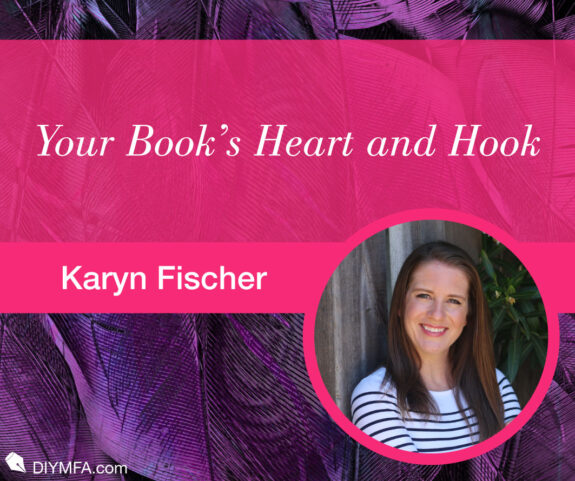Why both matter and how to get them on the page, from manuscript to query letter
On weekend evenings, when the kids are finally asleep, my husband and I turn on the TV and scroll through the streaming platforms, searching for something to watch. We have a hard time agreeing on how to spend our small window of uninterrupted TV time together, so, to lure him into watching something I want to watch, I rely heavily on movie trailers.
Movie trailers provide a snapshot of the whole movie: a sense of genre, setting, characters, story, conflict, tone. In essence, when you’re watching a trailer, you’re seeing the movie’s hook. And if the trailer is really good, you’re also seeing the heart.
The truth is, the best movies—and their trailers—ooze with both heart and hook. Because all great stories are a combination of both. We need the hook to draw us in and we need the heart to feel any sort of emotional connection to, or resonance with, the story.
In other words: come for the hook, stay for the heart.
So, what is the “hook” of your book? What is the “heart”? And more importantly, how do we make sure they’re both on the page, from your manuscript to your query letter?
The Hook
The word “hook” is thrown around a lot in the publishing industry—by agents trying to discern whether a manuscript is worth pursuing; by editors deciding whether to acquire a book; by the marketing and sales teams determining how to sell it to the marketplace, etc. But what does the term really mean? How can you figure out what your book’s hook is?
Think of the hook like that movie trailer and all that it encompasses: the genre, setting, conflict, tone, story, and characters. It’s what is going to make your book stand apart from others on the shelves, and make a reader think—yes, I need to read this one!
The hook is the external story—the plot, in other words. It’s the premise, coupled with any noteworthy positioning details (genre, author, comparative titles). The hook is the essence of what happens in your book.
How to find your hook
The first question to ask yourself when drafting your novel is: What is my story about? What happens? Also: Who is the character? What do they want? What are the obstacles? And what are the stakes?
Try to answer these questions in one or two sentences—a quick 50-words-or-fewer line. In the movie industry, this is called the “log line.”
One place I look at for examples of these hooks are in the book deals announced in Publishers Weekly and Publishers Marketplace. At the time of my writing, a deal was recently announced in language that reads like this: “Jenny L. Howe‘s debut Love at Full Tilt, in which a plus-size teen secures a highly coveted spot in an exclusive scavenger hunt at a world-renowned amusement park, only to have her carefully laid plans derailed by a cute fellow competitor who’s determined to win her heart.”
Sounds fun, right? But specifically, what do we get from this language? We get:
- The character: a plus-size teen
- Their (implied) desire: to win this exclusive scavenger hunt
- The obstacles the character will face: a cute fellow competitor
- The book’s (implied) stakes: losing the hunt (and maybe her heart?)
- The setting: a world-renowned amusement park
- Audience: YA
- Genre: Romance & Adventure
To find your hook, try writing a 280-character pitch, or movie log line for your book. Now make sure to include these details in your query letter as well.
The Heart
If the hook answers the question why should I read this book?, then the heart answers the question why should I care about this book? The heart of a book is the reason why people fall in love with it. It’s what connects them on a deeper level to the reading experience. It’s the emotional resonance that keeps them pinned in the hammock as they devour your story.
A book’s heart makes readers feel seen, like they could be reading about themselves. Fiction is a mirror into real life, even if it’s set in another time or imagined place. And that thing that makes readers feel like their world is being reflected to them, well, that’s the heart.
The Heart of your book is comprised of two things: the point your story makes (its theme); and your character’s internal arc of change.
How to find your book’s heart
The first question to ask yourself here is: What is the point of my story? What am I trying to say about the world or the experience of being human? Is it that life is richer with friends? Is it that love is the best medicine? What theme are you writing about? Is it a story about redemption or forgiveness? Grief or acceptance? Learning how to trust oneself or others?
Like an article’s thesis, the point is the glue that holds everything together and is what you’re trying to prove through the events of your book. Without a point to your story, your story risks having no heart, and therefore no readers.
The second piece you want to figure out is: How does your character change throughout your book? All stories are about character transformation. They’re about that internal arc of change, or the emotional journey, the protagonist is going through as the events of the plot put them through the ringer.
An Example of the Hook and the Heart
Let’s take the movie Wedding Crashers as an example.
The trailer shows scenes of two friends going from wedding to wedding they aren’t invited to, in the hopes that they can bed women, but then Owen Wilson’s character, John, meets Claire…and she’s a game-changer. He quickly learns he wants more from her than a one-night stand. In essence, that’s the movie’s hook. But the heart is the friends’ character change, as they learn that love is better than random sex with strangers. The movie’s point is that life is better when you’ve found your one person.
In the query letter and the manuscript, it’s the marriage of these two pieces…the hook and the heart, the plot and the character, the external and internal journeys…that is going to draw in readers and make them fall in love with your book.
These elements need to be front and center in both the manuscript and your query letter, for readers (and agents and editors) to read your book all the way through.
Think of your query letter like that movie trailer—it’s a tool you’re using to convey what kind of experience your audience will have with your book. Many querying writers include much of the hook in their letters, but they forget about the beating heart of the book—the character and the issue inside themselves that they must figure out by the book’s end. Their point doesn’t shine through.
But the truth is, mastering these foundational elements of fiction and learning how to convey them succinctly, is the best way to help your book find its way to the hands and hearts of readers.

Karyn Fischer is a children’s book and YA literary agent at BookStop Literary Agency and certified book coach for Story and Prose Book Coaching and Editorial Services. Before turning to agenting and coaching, she was a serial publishing intern, a bookseller and book buyer at an indie bookstore, and an agency assistant. She holds an MFA in Creative Writing and writes middle grade and young adult fiction. By offering 10+ years of industry knowledge, tough love and honesty, and true passion, she helps aspiring bestselling fiction writers hone their craft and write better books so they’re more likely to get published.







